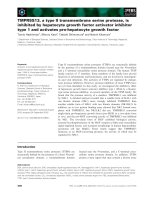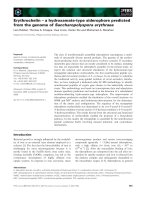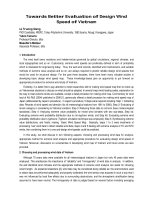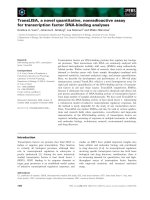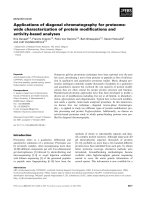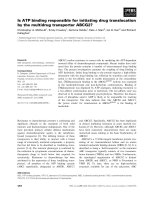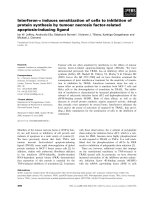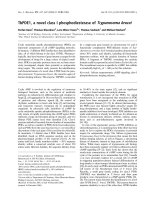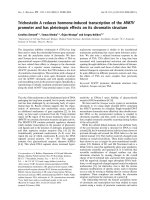Tài liệu Báo cáo khoa học: "TOWARDS A CORE VOCABULARY FOR SYSTEM A NATURAL LANGUAGE" potx
Bạn đang xem bản rút gọn của tài liệu. Xem và tải ngay bản đầy đủ của tài liệu tại đây (292.72 KB, 3 trang )
TOWARDS A CORE VOCAIIULARY FOIl A NATURAL I.,ANGUAGE
SYSTEM
I lubcrt l.chnmnn
IBM l)cutschhmd Gmbll, Scientific ('enter
institute for Knowledge Based Systems
Wilckensstr. la
I)-69(10 11cidelbcrg, (;ci'many
lhnaih !,1'~!! at I)! ll)iBM I.BITNI'71'
ABSTRACT
The desire to construct robust and portable na-
tural language systems has led to research
on
how a core vocabulary for such systems can be
defined. Stalistical methods and semantic criteria
for doing this arc discussed and compared. Cur-
rcnlly it docs not seem possible to precisely de-
fine the notion of core vocabulary, but it is
argued that workable criteria can nevertheless be
['o1.1110. l:inally it is emplmsized that
the
imple-
mentation
of
a
core
vt~cabulary must be seen as
a long-range research prt~gram rather than as a
short-term goal.
Motiva!ion
Rcasearch on natural language processing sys-
tems today strives for the construction of robust
and portable systems) A system is robust, if it
can handle a large variety of user inputs without
giving up or producing unexpected results. A
system is portable in the sense intended here, if
it is not geared to a single subject domain, but
can be ported with a reasonable effort
to
a vail-
ely of subjccl domains. It is common under-
standing that there cxisls
a
t:t:llhal [i'aglnt'.tlt of a
language which I. is required for dealing with
virtually any subject d(~main, anti 2. is invariant
with respect to meaning and use accross subject
donmins, it is of course a non-trivial empirical
question whether such a cen{ral fragment really
exists, and if so, to say what it is, but a number
of
researchers scenl
tO
share the asstllnption that
it does (ef. e.g. Alshawi ct al. (19R8)). Any ro-
bust and portablc system would then have to
handle this core fi'agmcnl.
in this paper I am concerned with a second
- related - assumption, namely that there ex-
ists a core vocabulary which is needed for handl-
ing any subject domain. 'llfis assumpti(m is also
shared by many researchers, and it tmdcrlies the
production of basic vocabularies for language
learning such as Ochlcr (1980). l.Jsually the att-
thors claim that their word lists are I)ased
on
statistical investigations, but they also emphasize
that. they did not slavishly stick to the statistics
but used additional crilcria such as "usage
value", "availability", "familiarity", or
"lcamability" without ever saying how these are
eslablished.2
I will address the following questions:
I. llow can the intuilivc notion of core vocab-
ulary be properly dciincd?
2. llow can statistical methods be employed
to define a core vocabtdaD, and how do they
relate to semantic criteria?
3. What semantic criteria can be found to de-
fine a core vocabulary?
Definitions of a core vocabulary
"l:here are several ways
to
define core
vocab,lary, I can think of the following three:
1. The core vocabulary consists
of
the n most
frequent words of a hmguage.
2. The core w~cabulary is that vocabulary
which is common to all nativc speakers of
a language.
3. The sema,tic core vocabulary consists of
lhose words which suffice to dcfinc all of the
remaining vocabuh~ry
of
a language.
The first two definitions call Re" statistical
methods which shall be discussed in the next
gcction, and the third onc obviously requires a
.~cmanlic approach which shall bc discusscd in
~cclion "Soma,tic crilcria".
Statistical
methods
l:rcqucncy counts have well established the basic
propcrtics of the frequency distribution for text
corpora. Thus in Kuccra and l;rancis (1967) we
get coverage ligures like lifts lbr their complete
corl~US of about I million tokens:
10
most frequent words:
100
most frequent words:
1000 most frequent words:
24.26 %
47.43 %
68.86 %
The research deso'ibed here has been comlucted i. the eonh;xt of the I .I I,O(; project (I lerzog et al., 1986).
II has profiled fi'om inlensive discussio.s with R. Maye,'. Mnch of the underlying statistical work on text
corpora is dec Io U, Bandara and (L Walch from Ihe speech recognition project SPRIN(] (Wothke et
at., 1989).
Our investigations ;ire based (.I (~erman, but for ease of refere.ce also some l!nglish examples are given.
- 303 -
These figt,rcs vary only slightly with corlms size,
and also for German similar values are observed.
! lowevcr, while coverage figures are rather stable
with respect to the n most frequent words of a
corpus, what are tile n most frequent words may
vary widely with corpora or subcorpora. Two
parameters rcsponsible for this variation are ob-
vious:
I. Subject matter and
2. ' Communicative function.
Thus in the "Kultur" section of a newspaper
which we have analyzed we see that words like
Musik, Theater, Regisseur,
etc. occur with a
drastically higher freqt, ency than in the other
sections, which of course can be attributed to
subject matter. 13ul personal pronouns, in par-
ticular 1st and 2nd person pronouns, also show
a much higher frequency, and this can hardly be
attrihutcd to subject matter, rather to different
communicative functi(ms of feuillet(mistie writ-
ing and say economic news.
All of tiffs relates of course to tile much dis-
cussed issue of what c,mstitutes a representatitve
corpus for statistical linguistic analysis. Since
specific subject matters and communicative
functions vary in importance for different speak-
ers of a language, it will be difficult if not ina-
possible to eliminate arbitrariness. Rather, a
definition of representative corpus must take
into
account tile research goals pursued.
For a natural language system which is sup-
posed
to
analyze and generate texts,
to
engage in
dialogues with users, and which is to acquire
knowledge fi'om the analysis
of
definiti(ms
and
rules formulaled in natural language,
one
needs
a corpus of texts where all these aspects are suf-
ficicntly rcprcscntcd. We were able to draw upon
a wtriety of corpora none of w[fich would sh()w
all the featt, res rcquircd, but the combination of
them seems to be quite reasonable.
We conlpared Ihe fi)llowing five word lists:
I. Oehlcr (1980): (;rundwortschatz consisting
of 2247 words,
2. Erk (1972): scientific texts from 34 disci-
plines, 1283 words with fl'cquency > 20,
3. Pregel/Rickhcit (1987): texts by primary
school children, 593 words with frequency
> 20,
4.
SPRING-corpus of newspaper texts, 2733
most frequent words,
5. I)UI)EN (1989): definitions for words be-
ginning with a, 2693 words with frequency
>4.
Frona these, word lists
IL
were formed consisting
of those words occurring in at least n of the ori-
ginal word lists (I < n < 5). The lengths of these
lisls are B~: 5409,
!12
: 2248, l.h: 1215, B4: 565, and
B5 : 116.
The size of /Is shows thai a really common
core of a varicty of texts may be extremely small,
the successive losening of rcstrictimls used here
allows for a balanced extension of this very smaU
core. The list//3 was chosen as the statistical core
vocabulary serving as a base for applying se-
mantic criteria, becat, se the overall core vocabu-
lary was envisaged to have a size of approx. 1500
words. Inspection shows that many intuitively
basic words and very few idiosyncratic words are
contained due to the method of intersecting the
word lists, l lence,
!1~
seems quite reasonable.
Semanlic criteria
If one takes tim n most frequent words of any
frequency count one will no doubt discover that
these words will not exhibit a linguistic closure
in the sense that natural scntcnces can be formed
with all and only the words in the set. l:urther
one will see that semantic relations will be in-
complete. Thus
one
tinds in Oehler (1980) which
is based on the old Kacding count that
weiblich
(female)
occurs but not its antonym
re&milch
(male).
For a core vocabulary to bc set up for a
natural language system, 1 think, tmc must strive
for lingt, istic closure, since otherwise, one cnds
up with words one cannot use. This means that
you cannot base the core w~cabulary on fre-
quency counts alone.
l~urthermore, one cannot expect that one will
imve just the vocabulary needed to formulate
delinitions for the words in the list chosen. To
avoid circularity, one will have to accept that
certai,i words cannot bc defined wilhin the
vo-
cabulary,
but one will also have to accept that
for some words less
than
complete definitions
can be given. Because of this lack of delinability,
a sere'retie core wwal,llary can only be under-
stood as an approximativc notion geared towards
"the best cmc can do". What one can hope to
do,
is
to
define
1. taxonomic rdations,
2. "selcctional restrictions" or constraints
on
seunauflic compatibility,
and
3. meaning rules of arbitrary complexity (in-
cluding classical definitions).
1 propose to formulate all of these typcs of rules
in natural language for
B3
trying to stay within
at least tile vocabulary of B, , to add lhe words
used in the fommlations to the original set, and
continue until one cannot think of further rules.
I claim that one can achieve a fixed point from
where on no new words are added to tim set, and
that at this moment one has reached a rather
good approximation to a semantic core vocabu-
lary.
There is undoubtedly a relationship between
frequency and semantic relevance: since
taxonomic relations are often exemplified by
anaphoric references, since semantic compatibil-
ity constraints lead to tile co-occurrence of ap-
- 304 -
propriate words, and since other more complex
semantic relationslfips arc bound to be exhibited
in the various threads of discourse, one has all
reason to expect a certain amount of congruence
between frequency counts and the semantic core
vocabulary as defined above.
The work on fimnulating taxonomic re-
lati(,ns, semantic constraints and other meaning
rules is underway, and since it will inw,lve all of
the w)cabulary, linguistic closure will be achieved
at the same time.
As an example, take a taxonomic rule for
Arm which is in Bs
Jeder(B3)
Arm ist Tei1(B4) eines
KiSrpers(B3)
(Every arm is part of a body.)
The word Kreperteil (body part) is only avail-
able in Bj and was therefore not used, or instead
o1' 7"eil one could also have used Glied(B3,
member), bu! then the rule would not have
covered arms of machines or rivers. This high-
lights a big problem in the natural language for-
mt, lation of meaning rules: how is ambiguity
dealt with? Space does not permit a full dis-
cussion here, therefore suffice it to say that it is
one of our research goals to formulate meaning
rules which specify criteria for disambiguation.
Linguistic description
The
preceding discussion has concentrated
on
how to establish a core vocabulary. Now a few
brief remarks shall follow on how the words of
the core vocabulary can bc linguistically de-
scribed.
'l'he
morphology of I:mguagcs such as
(]crman is well understood and has been coded
for an extendcd vocabulary in Ihc lexical data-
base of the IJ:,X project (llamett ct al., 1986).
This database also conlains dctailcd syntactic
inforuaation, in pa~l.icular on government pat-
terus.
It is the description tat' lhe semanlie (and
pragmatic) properties of many words one wouhl
obviously wanl h) include in a core vocabulary
lhat will confront us with huge unsoivcd theore-
tical problems. Be it modal verbs or proposi-
tional attitudes, sentence adverbs or "abstract"
nouns of various kinds, hwestigations on some
individual words havc generated heaps of litera-
ture, for others it seems that people have
not
even dared to look at thcm. l)oes this make the
enterprise of implementing a core w)cabulary a
futile one? I think not. I think the implementa-
tion of a core w)cabulary should be seen as a
long-range research goal for both computational
and theoretical linguistics, and filrthermore that
natural language systems provide a good envi-
ronmcnt for doing experiments in semantics, be-
cause they encourage an integrated treatment of
linguistic phenomena.
Conclusions
()ur research on establishing a core vocabulary
tor German in the framework of the I,I1,OG
project Ires revealed that currently no absolute
definition can be given, but ways have been
shown how to arrive at a working dclinition with
respect to the objectives of natural language sys-
tems. It has been shown that both statistical
mclhods and semanlic criteria can, and I think,
have to contribute to the establishment of a core
vocabulary.
The linguistic description and thus the im-
plcmentation of a core vocabulary depends
heavily on progress in theoretical linguistics, in
particular in semantics and pragmatics, but 1
want to stress that h)cussing on a core w~cabu-
lary is a fruitful way to direct linguistic research,
which can be supported by the need for inte-
graled treatments in natural language systems.
References
Alshawi, !I., D. M. Carter, .I. van F, ijck, R. C.
Moore, I). B. Moran, ! ;. C. N. l'crcira, and A.
G. Smith (1988):
"Research Programme in Na-
tural language Processing - Annual Report",
Nattie Project Document NA-16, ('ambridge:
SR! International.
Barnett, B., 11. l,chmann, M. Zocppritz
(1986): "A word database for natural language
processing", Proceedings I lth lnterm~tional Con-
.ference
OlZ
Complllalional Lingui.t'tic,~ COI.ING86
Auyttst 25th to 29th, 1986, Bonn. l,'e&,ral Repub-
lit: of (;ermany. 435-440.
I;,rk, !!.
(1972): Zur Lexik wisscnschafificher
I,'achtexte, Mi'mchen: I h, eber.
Ilcrzog, O. et al. (1986): "I.II.OG l,in-
guistic and Ix,gic Mcthods Ibr the ('omputa-
tional Undcrshmding of (;crvnan",
IJLOG-Report Ib, Stuttgart: IBM I)eutschhmd.
Kucera, 1 I., W. N. Francis (1967): Computa-
tional ,4nalysis tf Present-Day /Irnerican F, nglish.
Providence, Rh Brown University Press.
Oehlcr, II. (1981)): KLETT Grund- und
Auflmmvortschatz Deutsch. Stuttgart: Klett.
l'regel, D., G. Rickheit (1987): Der
Wortschatz im Grumlschulalter. I iildeshcim:
()Ires.
Wothke, K., U. B~mdara, J. Kempf, E.
Keppel, K. Mohr, G. Walch (1989): "The
SI~RING Speech Recognitk)n System for
German", in: Proceedings of Eurospeech "89.
VoL 2, 9-12.
- 305 -
